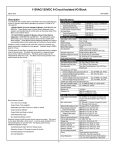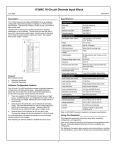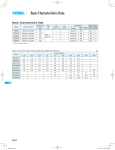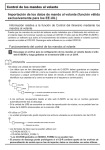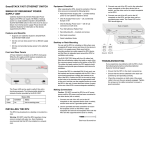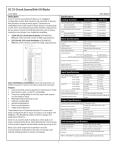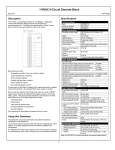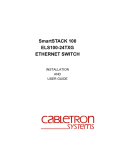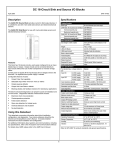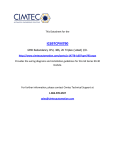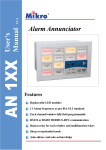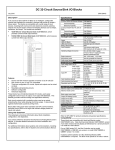Download Genius AC 8-Ckt Isolated Blocks datasheet, GFK-0040E
Transcript
This Datasheet for the IC660BBS102 Block 115Vac/125Vdc Low Leak Isolated I/O, w/Failed SW Diagnostics, 8 Circuit. http://www.cimtecautomation.com/parts/p-14439-ic660bbs102.aspx Provides the wiring diagrams and installation guidelines for this GE Series 90-30 module. For further information, please contact Cimtec Technical Support at 1-866-599-6507 [email protected] 115VAC/125VDC 8-Circuit Isolated I/O Blocks June 2002 GFK-0040E Description ____________________________________ Specifications _________________________________ Catalog Numbers 115 VAC/125 VDC Isolated Genius I/O blocks have four isolated groups of two I/O circuits, each rated to operate at a nominal 115 volts AC or 125 volts DC. 115VAC/125VDC 8 Circuit Isolated I/O Blocks (IC66*BBS102 and BBS100). These blocks report a Failed Switch diagnostic if any output’s commanded state is not the same as the actual state of the block’s own internal switch. 115 VAC/125VDC Isolated I/O Blocks without Failed Switch Diagnostic (IC66*BBS103 and BBS101). For applications where field wiring such as manual switches will be wired in parallel with block outputs. These blocks ignore differences between an output’s commanded state and the actual state of the block’s internal switch. 115VAC/125VDC Isolated I/O Block: Terminal Assembly Electronics Assembly 115VAC/125VDC Isolated I/O Block, No Failed Switch: Terminal Assembly Electronics Assembly Block Specifications Size (height x width x depth) Weight LEDs (I/O Block) LEDs (each circuit) Block to block Isolation Heat Dissipation Isolation is rated to withstand 250 VAC/VDC continuous between any group and ground or between any two groups. Transient rating is 2000V peak for 10 sec. Control power for the block is tapped off the input/output device voltages wired to the terminals. The block has terminals for a separate power source for the internal electronics. The block power supply can be independently either AC or DC. The block need not be powered in the same manner as the circuits. Required control power Operating voltage (one source) Frequency Power supply dropout time Input Specifications Input processing time (typical) Selectable input filter times Input diagnostics IC66*BBS102, replaces IC66*BBS100 IC66*TSS100 IC66*EBS100 IC66*BBS103, replaces IC66*BBS101 IC66*TSS100 IC66*EBS101 8.83” (22.44cm) x 3.34” (8.48cm) x 3.91” (9.93cm) 4 lbs. (1.8 kg) Unit OK, I/O Enabled On logic side of switch 1500V 16.8W max. with 8 inputs on, 45.6W max. with 8 outputs at 2 Amps 8 Watts maximum (block only) AC: 93-132VAC, DC: 105-132VDC AC: 47-63 Hz, DC: 10% maximum ripple AC: 1 cycle, DC: 10ms AC: 2ms + filter, DC: 0.8ms + filter 10 to 100ms in 10ms increments Open Wire, Overtemperature, Loss of I/O Power, Failed Switch Non-tristate input, OFF state min. voltage across input device (IN to H) AC: 60V RMS, DC: 70 VDC max. leakage through input device AC: 1 mA, DC: 2mA Non-tristate input, ON state max. voltage across input device (IN to H) AC: 20V RMS, DC: 35VDC max. switch current threshold AC: 6mA RMS, DC: 5mA Tristate input, voltage across input device (IN to H) OFF state acceptable voltage AC: 16V RMS-40V RMS, DC: 16 VDC-35 VDC ON state maximum voltage AC: 4V RMS, DC: 3.5 VDC Input load network, Resistor to N: 13K Ohms Input load network, Capacitor to BBS100 and BBS101: 0.22 µf H: BBS102 and BBS103: 0.1 µf 115V 50/60 Hz 125 VDC Isolated In/Out Output Specifications Ckt. output current (steady state) AC: 2 A RMS, DC: 2A resistive (1A inductive*) Max. inrush current Up tp 2 cycles: AC: 25A peak, DC: 25A peak (10ms max). 2-6 cycles, AC: 14 Amps peak Output Leakage (maximum) BBS102 and 103, AC: 7mA, DC: 2mA Current at 0 volt output: BBS100 and 101, AC: 13mA, DC: 2mA Output Leakage (maximum) BBS102 and 103, AC: 65V, DC: 40V Voltage at open output: BBS100 and 101, AC: 95V, DC: 40V Output switch (OFF to ON/ON to OFF): Zero crossing Maximum switching frequency once per second Turn-on delay (maximum AC: 0.5 Hz + 1ms, DC: 1ms Voltage drop (at 2A) 2.5 volts Voltage drop (at 30A inrush) 10 volts Minimum load (No Load BBS102 and BBS103, AC: 25mA, DC: 10mA disabled), Resistive: BBS100 and BBS101, AC: 30mA, DC: 10mA Minimum load (No Load BBS102 and BBS103, AC: 40mA, DC: 10mA disabled), Inductive: BBS100 and BBS101, AC: 100mA, DC: 10mA No Load enabled threshold 50mA Maximum block output current 15 Amps at 35 ° C, 7.5 Amps at 60°C Fusing Internal electronic short circuit trip. 100ms (AC), 10ms (DC) long time trip Output diagnostics Short Ckt, Overload, No Load, Overtemp., Loss of I/O Power. BBS100/102: Failed Switch * DC inductive load rating is 2A with external flyback diode or other coil suppression. Features Block features include: AC or DC circuit voltage Output Pulse Test capability Selectable Input Filter Time from 10ms to 100ms Output powerup defaults Output Hold Last State or default CPU Redundancy type Bus Switching Module control Electronic fusing is built into each circuit used as an output. The circuit is shut down 5µS after a short occurs. It can be easily restarted from a Hand-held Monitor or from the CPU. The blocks perform these additional diagnostic checks: Environmental Specifications Overtemperature Open Wire for tristate inputs. Detection of loss of I/O power on pairs of circuits Overload Detection and Shutdown No-Load Detection Operating Temperature Storage Temperature Humidity Vibration -0° to +60°C (32° to +140°F) -40 °C (-40° to +212°F) 5% to 95% (non-condensing) 5-10Hz 0.2” (5.08mm) displacement, 10-200Hz at 1G Refer to GFK-0867 for product standards and general specifications. 1 115VAC/125VDC 8-Circuit Isolated I/O Blocks June 2002 GFK-0040E Using this Datasheet ______________________________ Removing an Electronics Assembly _______________ This datasheet summarizes information about block installation, configuration, and diagnostics. The block’s Electronics Assembly can be replaced with a compatible model without removing field wiring or reconfiguring the block. Your primary reference should be the Discrete and Analog Blocks User’s Manual. It includes detailed instructions for block installation and configuration. Electronics Assembly Retaining Screws (Qty. 2) For additional information about systems and communications, including bus specifications, refer to the I/O System and Communications Manual. Compatibility ___________________________________ Hand-held Monitor: These blocks are fully compatible with a Hand-held Monitor identified by catalog number IC66*HHM501. They may also be used with HHM500. HHM501 is required to change baud rate configuration, or to configure the block for redundancy. Terminal Assembly I/O Blocks: These blocks are backward-compatible with previous block versions (IC66*CBS100, IC66*BBS100, and IC66*BBS101). They may be used as replacements for earlier versions. However, their Terminal Assemblies are not backward-compatible, as explained below. Connector Pins Electronics Assembly: Electronics Assembly IC66*EBS100H may be used to replace any Electronics Assembly IC66*ELS100 or IC66*EBS100. Electronics Assembly IC66*EBS101C may be used to replace any version IC66*ELS100, EBS100, or EBS101. These Electronics Assemblies draw lower leakage current (7mA) than earlier versions (which drew 13mA). 1. Unscrew the retaining screws at the top and bottom of the block. 2. Using a Block Puller (IC660BLM507), engage the tabs in the first vent slots. Move the tool to the center of the block and squeeze the handle. Terminal Assembly: The Terminal Assembly for these blocks (IC66*TSS100E) is not compatible with some earlier versions of their Electronics Assemblies (IC66*EBS100A to G, or IC66*EBS101A or B). If Terminal Assembly IC66*TSS100E will be used to replace an earlier version of the Terminal Assembly, it will also be necessary to upgrade the Electronics Assembly. This can be done by replacing the entire Electronics Assembly with version IC66*EBS100H or IC66*EBS101C, or later. It can also be done by upgrading the Electronics Assembly firmware. 3. Pull the Electronics Assembly upward. Installation Instructions ___________________________ 1. Warning If power is applied to the field terminals, power is also exposed on the connector pins at the base of the Terminal Assembly, and electrical shock hazard exists. Do not touch the connector pins! Death or injury may result. Inserting an Electronics Assembly Carefully inspect all shipping containers for damage. If any equipment is damaged, notify the delivery service immediately. Save the damaged shipping container for inspection by the delivery service. After unpacking the equipment, record all serial numbers. Save the shipping containers and packing material in case it is necessary to transport or ship any part of the system. Align the Electronics Assembly in the guides and push down firmly. Caution Do not exert excessive force; it may damage the block. 2. If unusual resistance is met, remove the Electronics Assembly. If power is applied to the block, DO NOT TOUCH THE CONNECTOR PINS! Inspect the Terminal Assembly, connector receptacle, and connector edge board (on the Electronics Assembly). Be sure the keying matches. Remove any obstacles and reinsert the Electronics Assembly. Pay close attention to the alignment of the guide pins. 3. Secure the Electronics Assembly with the screws on the top and bottom of the Terminal Assembly. Block Mounting Genius I/O blocks are considered "open equipment" and therefore must be installed within a protective enclosure. They should be located in an area that is clean and free of airborne contaminants. There should be adequate cooling airflow. The block can be mounted right side up, or upside down. Leave at least 2 inches of space between blocks. Mount the block by drilling two screw or bolt holes for 8-32 hardware. Position the block so that the notches in the upper and lower flanges line up with the mounting holes. Mount the block using 8-32 screws. Use star washers to provide ground integrity. Block Wiring __________________________________ All terminals accept one AWG #12 wire (avg 3.3mm2 cross-section) or two AWG #14 wires (each avg 2.1mm2 in cross-section). The minimum recommended wire size is AWG #22 (avg .36mm2 in cross-section). Terminals 1 - 4 can also accommodate spade or ring terminals up to 0.27 inch (6.85mm) wide with a minimum opening for a #6 screw, and up to 0.20 inch (5.1mm) depth from the screw center to the back barrier. Be sure unshielded wire ends are not longer than 2 inches (5 cm). Grounding The block’s mounting screws must not be used as the only means of grounding the block. Connect the green ground screw on the block to a reliable ground system using a short wire lead, minimum size AWG #12 (avg 3.3mm2 in cross-section). Do not overtorque the terminal screws. Recommended torque for all terminals is 6 in/lb (.678 N/M). Warning If mounting screws do not make good ground connection and the ground screw is not connected to a reliable ground, the block is not grounded. Electrical shock hazard exists. Death or personal injury may result. 2 115VAC/125VDC 8-Circuit Isolated I/O Blocks June 2002 GFK-0040E Serial Bus Wiring Circuit Power Using one of the cable types recommended in the System and Communications User’s Manual, connect the serial bus to terminals 1- 4. (If a Bus Switching Module will be connected directly to the block, see below instead). Each circuit pair can have its own power supply. All circuits must use either AC or DC power. If circuit power is AC, both circuits of a pair must be wired to the same AC phase. However, different pairs of circuits can be wired to different C phases. 1 SERIAL 1 If separate AC power is used for any group of circuits on a block, all power connections within the group must be wired to that same 120 VAC source. 2 SERIAL 2 Caution 3 SHIELD IN 4 SHIELD OUT H PHASE 1 N H If the block is at either end of the bus, connect a terminating resistor of the appropriate type (see the System and Communications User’s Manual for details) across its Serial 1 and Serial 2 terminals. Start of Bus PHASE 2 ~ INPUT DEVICE OUTPUT DEVICE 1 2 N End of Bus H PHASE 3 Terminating Resistor Terminating Resistor ~ ~ INPUT DEVICE 3 4 N H Serial 1 Serial 2 Shield In Shield Out Serial 1 Serial 2 Shield In Shield Out PHASE 2 ~ INPUT DEVICE OUTPUT DEVICE 5 6 N Wiring for I/O Devices For each input device, connect one terminal to the Hot side of AC power or positive side of 125 VDC. Connect the other to the I/O block at terminal 8, 9, 12, 13, 16, 17, 20, or 21. Wiring for a Bus Switching Module If the block will be a BSM Controller, install the Bus Switching Module at the block’s serial bus terminals. Attach the bus cables to the BSM terminals, as described in the Bus Switching Module datasheet. Wire the BSM like a load to circuit 1 by connecting either BSM pigtail wire to terminal 8, and the other to neutral or DC- (such as terminal 10). For each output, connect one terminal to block terminal 8, 9, 12, 13,16, 17, 20, or 21. Connect the other to the neutral side of AC power or the negative side of 125 VDC. The block must have both sides of power connected to it. Power Connections Only one wire need be run to the field device. Depending on the layout and current loads, hot connections can be bussed together and made by one wire to the block or power source. Neutral connections can also be bussed together and made by one wire. Up to five separate power sources can be connected to the Terminal Assembly. Circuit power and block power do not have to be the same type. Block power may be DC while circuit power is AC, or the reverse. Isolation is rated to withstand 250 volts AC or DC continuous between any group and ground, or between any two groups. Wiring for Tristate Inputs For input circuit configured as a tristate input, install a 5.1K ohm, 1/2 Watt or larger non-inductive resistor across the dry contacts of the input device. This added resistance is required to use the Open Wire diagnostic. Block Power For block power, connect a 115 volt AC or 125 VDC source to the top H terminal (5). Connect neutral to the N terminal (6). All H terminals are internally bussed, as are all N terminals. AC or DC Power Source 5 R or DC 6 N or DC H1 or DC 7 AC or DC Power Source AC or DC Power Source 8 9 N1 or DC 11 H2 or DC 3 4 N2 or DC 13 14 15 AC or DC Power Source 16 17 18 19 AC or DC Power Source 20 21 22 IN ~ 1 2 10 12 H N Interfacing Small Loads to an Isolated Block If any output will drive an inductive load drawing less than 50 mA, it may be necessary to add resistance at the load. See the Genius Discrete and Analog I/O Blocks User’s Manual for instructions. External Suppression If a contact is wired between the block and a load, install suppression across the load. Resistor capacitor suppressors are preferred for low current, high inductance loads. For a high-power load, instead use a voltage-clamping device such as a MOV. RC suppressors are also recommended to reduce electro-magnetic interference. H3 or DC 5 6 N3 or DC H4 or DC 7 Power supply-side switches may require line to line suppression if power is to be switched with devices energized. 8 N4 or DC See the Discrete and Analog I/O Blocks User’s Manual for more information about using suppression. 3 115VAC/125VDC 8-Circuit Isolated I/O Blocks June 2002 GFK-0040E Block Operation __________________________________ Open Wire: Voltage, but no current detected on tristate input. An Isolated block has four isolated groups of two I/O circuits, each rated to operate at a nominal 115VAC or 125VDC. Overtemperature: The block’s internal temperature exceeds 100°C. The block sends an OVERTEMPERATURE message and turns off the circuit. The block can be configured as an inputs-only, outputs-only, or combination block. Short Circuit: The instantaneous current on an output exceeds 30 Amps during the first two line cycles or 20 Amps thereafter. The block turns the output off within microseconds. If the block is configured as a combination block, circuits can be any mix of inputs and/or outputs. The actual state of each output will be returned to the CPU in the corresponding input reference location. The CPU can monitor the feedback state to verify (after an appropriate delay) that the output switching device has operated properly and that the load has the proper voltage and current applied. Overload: A load exceeds 2.8 Amps (2.0 Amps RMS) continuously for 100ms. The block turns the output off. No Load: Optional. The load does not continuously draw 50 mA from the output circuit. If the block is configured as an inputs-only block, all circuits must be regular inputs or tristate inputs. If the block is configured as an outputsonly block, all circuits must be be outputs; no feedback analysis will be performed. Failed Switch: For blocks IC66*BBS100 and BBS102, this diagnostic typically indicates that a circuit’s internal feedback state is not the same as the commanded state. Each circuit has its own LED. If the circuit is used as an input, the LED indicates the presence of threshold voltage at the input terminal. If the circuit is used as an output, the LED indicates the state commanded by the CPU. To second circuit in group H or DC+ Configured as an Input * Input Device All of these blocks may generate a Failed Switch diagnostic if internal failure of a switch is detected. Internal +5V Configuration _________________________________ MOV AC or DC Source Configured as an Output Blocks IC66*BBS101 and BBS103 ignore differences between an output’s commanded state and the actual state of the internal switch. They do not modify the output state if a discrepancy exists. Blocks BBS101 and BBS103 should be used in applications where mechanical switches on outputs would cause false Failed Switch diagnostic messages to be generated. I/O Smart Switch First, the block must be configured with a Hand-held Monitor to: Opto couplers Processor Output Device Field Connections N or DC- Preload Resistor 13K Terminal Assembly Internal Circuits Note: If a block is configured offline, it must be properly grounded and have a 75 Ohm resistor installed across its Serial 1 and Serial 2 terminals. See the Discrete and Analog I/O Blocks User’s Manual for instructions. The rest of the features can be configured either using a Hand-held Monitor, or by sending a Write Configuration datagram to the block from the host. To second circuit in group * .2µF for Block IC66*BBS100 and 102 .1µF for Block IC66*BBS101 and 103 LEDs _______________________________________ Feature The block's Unit OK and I/O Enabled LEDs show its operating status: Unit OK ON I/O Enabled ON Enter its Device Number (serial bus address). Enter its Reference Number (required only for IC600 and IC550 series PLCs only). Circuit or Block Factory Setting Selections Baud Rate B 153.6 std 153.6 std, 153.6 ext, 76.8, 38.4 Block functioning, CPU communicating Block I/O Type B input input, output, combination Meaning ON OFF Block functioning, No CPU communications for 3 bus scans AC/DC Circuit Voltage B AC AC or DC ON Blinking Block functioning, Circuit forced Pulse Test B enabled enabled, disabled Blinking ON Circuit fault, CPU communicating Input Filter Time B 20ms 10-100ms Blinking OFF Circuit fault, No CPU communications for 3 bus scans Circuit I/O Type C input input, output, tristate input Alternate Blinking Circuit fault, Circuit forced Report Faults C yes yes, no Synchronous Blinking No CPU communications - block number conflict Hold Last State C no yes, no OFF No block power, or block faulty Output Default C off on, off Report No Load C yes yes, no Overload Shutdown C yes yes, no BSM Present B no yes, no BSM Controller B no yes, no Output Timeout B 2.5 sec 2.5, 10 seconds Redundancy Mode B none none, standby, duplex Duplex Def. State B off on, off Config. Protect B disabled enabled, disabled Don’t Care For each input circuit, the circuit LED indicates the presence of threshold voltage at the input terminal. Output circuit LEDs show the state commanded by the CPU. Diagnostics __________________________________ The block’s advanced diagnostics provide the messages listed below. Fault messages can be cleared from the Hand-held Monitor or the CPU. Loss of I/O Power: One pair of switches is disconnected from field power. Result: if either of the disconnected circuits is an input, the block sets it to 0. Any disconnected output is turned off. The Loss of I/O Power diagnostic message is automatically sent to the HHM, but it is not automatically sent to the CPU unless the block is Pulse Tested. The Unit OK light will not blink if a Loss of I/O Power fault occurs. 4





